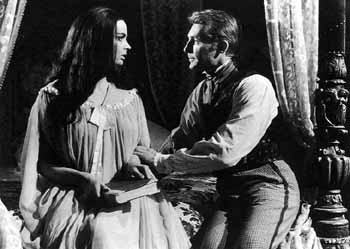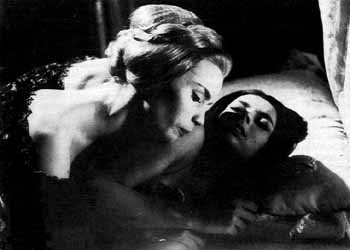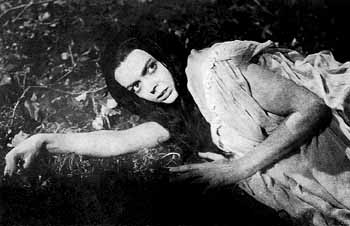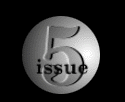|

Elizabeth (Barbara Steele) and Alan Foster (George Riviere)
get comfy in Castle of Blood.
The plot itself of Castle of Blood is initiated when a reporter, Alan Foster, tracks down Edgar Allen Poe for an interview. He finds him in a tavern, telling an enraptured audience the story of "Berenice." One member of that audience, Sir Thomas Blackwood, talks about "the Night of the Dead": "It is only from midnight tonight, the first midnight in November, until the sunrise that you may see the dead come back to perform again those tragedies which cost them their lives." But Foster objects: "I'm not afraid of the dead. Not at all. It's the living . . . My fear is of the living. They're the ones who can harm us." So Sir Blackwood (who we later find out is an ancestor of the "Hangman of London") offers a wager if Foster will stay the night in his castle. Foster agrees.
Foster soon finds himself amidst a veritable laundry list of haunted house paraphernalia: his short walk from the castle's rusty iron gate to the front door takes him through a graveyard where tree branches threaten to ensnare him and black cats hiss and arch their backs. In fact, once he's in the castle, wandering down the castle hallways while holding a lighted candelabra, we see fog, cobwebs, a grandfather clock that mysteriously starts and stops, doors that suddenly blow open and closed--in short, all the traditional trappings of a haunted house. Thus far the story even sounds a little bit like the Don Knotts comedy The Ghost and Mr. Chicken. Very traditional material indeed. But then things start to happen, and they are definitely not run-of-
the-mill haunted house material.

Julia (Margaret Robsham) makes advances on Elizabeth
(Barbara Steele) in Castle of Blood
Elizabeth makes her first appearance by suddenly grabbing Alan's shoulder while he sits at a piano. Alan recovers quickly, however, especially as Elizabeth soon tells him "I like you very much" and beckons him to follow her upstairs and sit beside her on her bed: "Come here and sit next to me." Foster has been a lonely man and he welcomes her comely attitude--but then Julia (Margaret Robsham) shows up and she immediately orders Elizabeth out of the room. "He was sent to see me!" Elizabeth complains.
Soon afterwards, we discover the castle is also inhabited by several other members of the undead. In contrast to Elizabeth, we know Foster is in trouble with Julia, for unlike the duality implied by Steele's face, Julia is haughty and distant and icy. She's absolutely beautiful, but her beauty is glacial. Her main interest seems to be Elizabeth's unrealistic view: "I've dreamed of this night--at last I can go away with the man I love," Elizabeth says to Julia. "You can't leave, Elizabeth. You're trapped in the castle," says Julia. But Elizabeth doesn't pay attention to her and lets Foster lavish her with attention: "I'm very attracted to you, my dear . . . I think you're the loveliest girl on this earth," he says. "Kiss me, love me, Alan," she says. "Love me. Oh, yes, my dearest. Keep on embracing me. I want to absorb the warmth of your body. Kiss me, kiss me warmly, dearest Alan. . . . You will give me life." Pretty scary language actually--especially when Foster discovers she has no heart beat. "My heart isn't beating, Alan. It hasn't beaten for ten years. I'm dead, Alan. Dead." But by this time, however, Foster is so crazed with lust that he refuses to believe what he has experienced. He heard the emptiness within Elizabeth's chest, but he disregards it completely. In this respect, Castle of Blood works as a cautionary tale about the destructive power of unbridled sexual desire.
Castle of Blood is Margheriti's best movie. His economical approach to filmmaking, where he utilized three cameras in a manner similar to TV sitcoms and soap operas, would have a detrimental effect on some of his subsequent movies, such as The Long Hair of Death, where the camera frequently drifts lazily around the edges of the scenes. But in Castle of Blood, Margheriti supplies some startling images, such as the overhead shot of Elizabeth's bed as she lay surrounded by her dead lovers or the low angle camera shots of the undead converging on Alan as he runs through the castle corridors and becomes trapped in a crypt deep below the castle. The later scene in particular becomes the great climax of the movie, a truly scary scene easily the equal of any scene in all of Italian horror, as Margheriti provides one close call after another as the undead follow Foster through the castle, intent on taking his blood and sustaining their lives for another year.

Elizabeth (Barabara Steele) in Castle of Blood
Margheriti would soon allow the fast, cheap method of filmmaking to take a toll on his films. His science-fiction movies of the '60s are frequently fun viewing, particularly Battle of the Worlds, where Claude Rains battles an errant meteor, but all too frequently these films look lethargic. With Castle of Blood, however, Margheriti contributed one of the most surprising and unique films of all Italian horror. The movie provides one of its most shocking moments at about the halfway point--when most of the cast is suddenly and shockingly killed. Castle of Blood leaves us wondering where the movie can possibly go, as almost the entire cast lay dead in Elizabeth's bedroom. But the movie does continue, as Foster continues his journey through the hallways of the Blackwood castle and encounters Dr. Camus--a famous doctor and scientist. Camus was exiled from the scientific community for his unusual practices: "I wanted to try some experiements and I wasn't allowed," he says. As a result, he rented the castle to conduct his experiments in private: "Away from a suspicious world," he says. He wants to prove that the senses are eternal and continue after death: "The senses remain strongest when a human being is torn from life by an act of violence … in other words, death isn't completely accepted unless the victim is ready to die."
We get to see the results of Dr. Camus' experiments worked out before our eyes with the rich baroque visuals supplied by Margheriti's camera within the elaborate and shadowy Blackwood Castle--a marvel of decomposition, decay, and decadence. As Foster and Elizabeth's romance develops, Margheriti creates a mood akin to necrophilia. It envelops the drama--as sexual desire becomes obsessive and destructive, embodied in the form of the bare-chested gardener, Herbert. He stalks the shadows of the castle, lusting for Elizabeth both while he's alive and for eternity in death. The castle becomes a huge, dusty crypt where the family secrets and deep, forbidden cravings--including lesbianism, in a shocking encounter between Julia and Elizabeth--are worked out before our eyes in the hypnotically-beautiful atmosphere of funeral lyricism created by Margheriti. (The lesbian encounter between Julia and Elizabeth is butchered and virtually incomprehensible in the American prints.)
Margheriti would remake Castle of Blood just six years later as Web of the Spider, but the remake is only a dim reminder of the original, and evidence of the power of black and white images over color--at least in the world of Italian gothic horror. Castle of Blood is the high point of Margheriti's career and one of the greatest films of the horror genre.
Italian Horror Menu page
Italian Horror: A Brief Introduction
Mario Bava: The Illusion of Reality
Mario Bava's Rabid Dogs
Mario Bava Biography
The Horrible Dr. Hichcock
The Devil's Commandment 
Castle of Blood 
Nightmare Castle
The Bloody Pit of Horror 
Italian Horror in the Seventies
Suspiria
Italian Horror Web Links
Photo credits: Dean Harris, Silent Scream, and Sinister Cinema.
|






